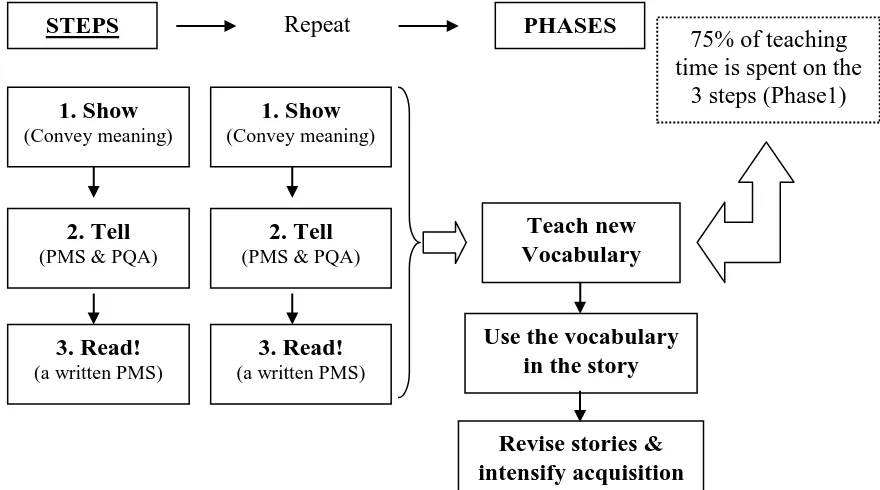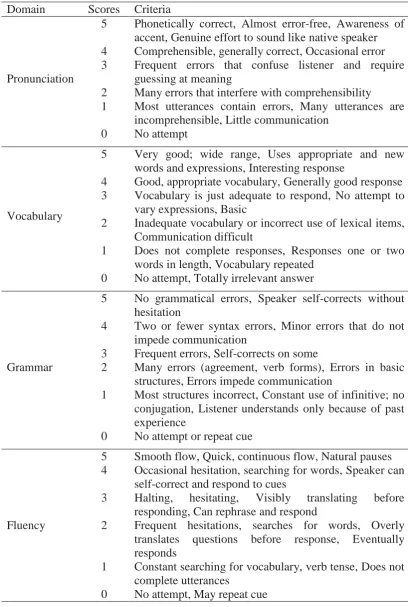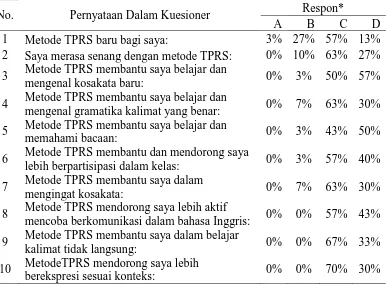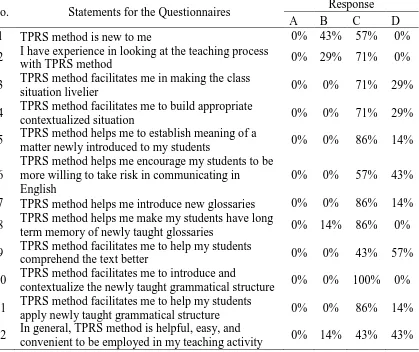1
Improving Speaking Skill by Using Teaching Proficiency Through
Reading and Storytelling (TPRS)
Lasim Muzammil
Kanjuruhan University of Malang, Indonesia [email protected]
Andy
Kanjuruhan University of Malang, Indonesia [email protected]
Abstract: Teaching Proficiency through Reading and Storytelling (TPRS) is quite essential to improve EFL learners’ speaking ability. It can be done successfully by means of the basic concept of TPRS known as comprehensible input in second language acquisition (SLA). This paper presents a study on learners’ speaking ability through TPRS making use of three important steps; Showing, Telling, and Reading. This is a quantitative study using quasi-experimental as the two intact groups are used; experimental and control group. The data are obtained from pre-test, post-test and questionnaires viewed from both students’ and teachers’ perspective. The data from pre-test and post-test are analyzed by using independent sample t-test. The experimental and control are ascertained to be homogenous in term of English performance from the pre-test analysis. The post-test are carried out from both groups after the treatment and the the result of the test are compared in order to prove if the null hypothesis is rejected indicaing that there is significant difference performance between the two groups. The result of the study is expected to be beneficial for English teachers, EFL learners, and furthur researchers.
Keywords: Speaking Skill, Teaching Proficiency through Reading and Storytelling (TPRS)
INTRODUCTION
Studying any languageincluding English as aforeign or and a second languagerequires an appropriate method in order to be effective and efficient to improve the language skills; listening, speaking, reading, and writing. The application of methods such as Audio Lingual Method, Grammar Translation Method, Direct Method, Total Physical Response, Communicative Approach, Contextual Teaching and Learning, and Communicative Language Teaching has their own strength and weaknesses. Therefore, a language teacher or a lecturer should be able to select the method mostly needed by learners based on their need
2
process in the classroom since it enables learners not only to be entertained but learned the language as well.
As most teachers and lecturers aware that speaking and writing are productive skills in English taking relatively longer time to master and therefore learners should learn this particular language step by step. The practice of speaking English is one of skills to give opinion, convey messages, give
comments, and refuse other people’s opinion whenever it is not in accordance
with our thought. Also, it is the ability to have question and answer in practicing to speak this language. Nevertheless, learners still have difficulties to convey message in English particularly their fundamental concept of having question and answer to undertand utterances from others. Therefore, this article discusses a method of teaching English by means of Teaching Proficiency through Reading and Storytelling known as TPRS.
Teaching Proficiency through Reading and Storytelling is one method to teach English designed to improve or develop fluency of using the target language to tell some interesting stories in teaching and learning process in the classroom. So, TPRS is a language teaching method designed to develop real fluency. Students and teachers spend class time speaking in the target language about interesting, comprehensible stories. Hedstrom (2012) states that stories are the heart of the method and a good story is one of the most valuable tools to deliver compelling comprehensible input to your students, but the story is only a part of it. To really understand TPRS we need to be clear on the theory that supports it. In other words, TPRS is a method that meshes seamlessly with the Natural
Approach, particularly the idea of Comprehensible Input.
3
responded positively to TPRS. Students were enthusiastic about the class and reported that the methods helped them to remember vocabulary, and understand English.
The next author, Watson (2009) did a comparison study on two
beginning high school TPRS classrooms and one traditional classroom by testing the students with a final exam and an oral exam. Results showed that the TPRS classes outscored the traditional students on both tests, and that the distribution was wider in the traditional classes. This means that when taught with traditional methods, some students fail and others succeed, whereas more students can succeed with TPRS. Meanwhile, Spangler (2009) found that middle school and high school students in TPRS classrooms significantly outperformed classrooms using Communicative Language Teaching on speaking, and that the two groups of students performed the same on reading and writing.
In addition, Foster (2011) found that TPRS students outperformed traditional classes on a grammaticality judgment task and on writing fluency, and equaled traditional classes on three other measures (speaking accuracy, writing accuracy, and reading). However, processing instruction students outperformed the other groups on speaking accuracy and writing accuracy of these
constructions. Processing instruction students equaled TPRS students on a
grammaticality judgment task and on reading, but underperformed TPRS students on writing fluency. Finally, Dziedzic (2012) compared four sections of Spanish 1: two that he taught traditionally and two that he taught using TPRS. Both groups also participated in sustained silent reading. At the end of the year, 65 students who had never learned Spanish previously took the Denver Public Schools
Proficiency Assessment. The groups did equally well on listening and reading, but the TPRS students significantly outperformed the traditional students on writing and speaking, with large effect sizes on these two production measures.
4
the traditional method of teaching English. Therefore, this research investigates
the learners’ speaking performance by using TPRS.
Objective of the Study
This research-based paper aims, in general, at investigating the different achievement between the use of TPRS in learning English as a Foreign Language (EFL) and the absence of TPRS to develop learners’ speaking performance. More specifically, the following research problems are proposed.
1. Does EFL learners’ speaking performance improve better by using TPRS method than those using the traditional one?
2. What are the students’ and teachers’ perspective about using TPRS method?
Hypothesis
It is assumed that there is significant difference between the use of TPRS and the traditional one and the use of this method has beneficial influence to
develop ESL/EFL learners’ speaking performance since it can perform better than
the traditional method of teaching English. Therefore, the theoretical hypothesis of this study is stated that the use of TPRS in teaching and learning English as a Foreign Language outperforms the traditional one.
METHOD
This is a research-based paper and the study was conducted to the
freshmen at Kanjuruhan University of Malang aimed at investigating the different achievement between the use of TPRS in learning English as a Foreign Language
(EFL) and the absence of TPRS to develop learners’ speaking performance. An experiment was carried and quasi-experimental study was used since the two existing groups were employed. The data obtained from speaking performance test were analyzed using independent sample t-test since the result of the test were taken from two different groupthe experimental and the control group.
5
the learners’ feeling and opinion after the use of TPRS but to the English teachers having experience in the application of TPRS as well.
The participants were taken from the freshmen at Kanjuruhan University of Malang taking English subject for non-English Education Department. There were sixty EFL learners in the second semester majoring different field of study. The rationale behind choosing these particular learners to be the subjects of this study is that they still have difficulties to express their idea in using English. Thirty (30) EFL learners become experimental group and the other thirty (30) become control group. Pre-test was assigned to both groups, experimental group and control group, and it was done in order to get to know the homogeneity of the group. Post-test was done in the form of Speaking Performance by telling a story in the stage of Reading in TPRS.
The Steps to TPRS
Gab (2008) introduced three steps of TPRS and these three basic steps to TPRS included: Show, Tell and Read. As these three steps are repeated, they lead into three phases. The following graphic organizer (Figure 1) illustrates the sequence and organization of a TPRS unit.
6 Step 1: Show
It is the step of conveying or establishing meaning. Step 2: Tell
It is the step of telling the story by making personalized question and answer (PQA) and personalized mini story (PMS)
Step 3: Read
It is the step of reading the story by different variation.
Data were obtained from speaking performance test to answer the first research question and from questionnaire to answer the second research question. Speaking Performance Test was done by the participants after having experience in TPRS teaching learning process for experimental group and having experience of teaching learning process in traditional method for control group. Both
experimental and control group have eight meetings of English instruction before doing the test. The participants were to choose one of the three stories provided by the instructor and the stories included were (1) At a Party, (2) In the Bathroom, and (3) The Rabbit and the Butcher. They had to tell the story again using their own style and different format of the texts. While telling the story, the utterances were recorded using their own cellphone, and the result of the recording was submitted to be transcribed and analyzed.
Data from questionnaire were required to obtain both learners’ and
7 Table 1. Scoring rubric of speaking test
Domain Scores Criteria
Pronunciation
5 Phonetically correct, Almost error-free, Awareness of accent, Genuine effort to sound like native speaker 4 Comprehensible, generally correct, Occasional error 3 Frequent errors that confuse listener and require
guessing at meaning
2 Many errors that interfere with comprehensibility 1 Most utterances contain errors, Many utterances are
incomprehensible, Little communication 0 No attempt
Vocabulary
5 Very good; wide range, Uses appropriate and new words and expressions, Interesting response
4 Good, appropriate vocabulary, Generally good response 3 Vocabulary is just adequate to respond, No attempt to
vary expressions, Basic
2 Inadequate vocabulary or incorrect use of lexical items, Communication difficult
1 Does not complete responses, Responses one or two words in length, Vocabulary repeated
0 No attempt, Totally irrelevant answer
Grammar
5 No grammatical errors, Speaker self-corrects without hesitation
4 Two or fewer syntax errors, Minor errors that do not impede communication
3 Frequent errors, Self-corrects on some
2 Many errors (agreement, verb forms), Errors in basic structures, Errors impede communication
1 Most structures incorrect, Constant use of infinitive; no conjugation, Listener understands only because of past experience
0 No attempt or repeat cue
Fluency
5 Smooth flow, Quick, continuous flow, Natural pauses 4 Occasional hesitation, searching for words, Speaker can
self-correct and respond to cues
3 Halting, hesitating, Visibly translating before responding, Can rephrase and respond
2 Frequent hesitations, searches for words, Overly translates questions before response, Eventually responds
1 Constant searching for vocabulary, verb tense, Does not complete utterances
8 FINDINGS
The finding of this study was divided into two parts. Part one is the experimental result and part two is the learners’ and lecturers’ perspective on using TPRS method. This first part is related to the finding of the study before and after the treatment of TPRS toward two different groupthe experimental and control group. The experimental group is a group using TPRS method and the control group is a group using non-TPRS method. As it was said in the previous section of this paper regarding the measurement of speaking performance based on the scoring rubric containing the domain of pronunciation, vocabulary,
grammar, and fluency become one part of speaking performance. The result of the test after the treatment was measured using SPSS and it was found that the
speaking performance of the two group was significantly different at .05 level since the probability due to sampling error was .015 which was lower than the significant level (.015<.05) as it was seen in Table 2.
Table 2. Mean Difference in Speaking Performance after the Treatment
No. Group N Mean Std.
Deviation F Sig. t Sig.* 1. Experimental
(TPRS)
30 70.83 16.56 10.28 .002 2.52 .015
2. Control (Non-TPRS)
30 62.17 8.97 * Significance was set at .05 level.
From Tabel 2, we can say that the null hypothesis which was stated that
“the learners’ speaking performance using TPRS method do not improve better
than the non-TPRS” is rejected since the probability due to sampling error is .015 which is lower than the significant level which is set at .05 ( = .015 < .05). It means that there is significant different speaking performance between the use of TPRS and non-TPRS. On the other hands, the researcher’s hypothesis which was
stated that “the use of TPRS in teaching and learning English as a Foreign
9
(TPRS) group performs 8.66 better than the control (Non-TPRS) group (70.83-62.17=8.66).
The mean difference of each domain on speaking performance can be seen in Chart 1 and we can say that the domain of pronunciation (0.80) is the higherst score of speaking performance compared with the other domains like vocabulary (0.40) and grammar (0.43) and the domain of fluency is in the lowest score compared with the others. It means that EFL learners’ pronunciation improve the most and the fluency least when they are performing their speaking skill after the application of TPRS method.
Chart 1. Mean Difference of each Domain on Speaking Performance
The second part of the finding was related to the perspective of learners and lecturers on the application of TPRS. First, it was found that most participants (57%) agreed that TPRS was a new method for them and they also agreed that this method made them feel happy (63%). The learners strongly agreed to say that this method helped them to learn new vocabularies (57%) and accepted grammar (63%). Next, learners were helped to understand reading in the story and they (50%) strongly agreed because the steps done in TPRS lead them to understand the story easily. This method also encouraged them to participate in listening to
the other friends’ storytelling indicated by having agreement of (57%).
Furtermore, they agreed to state (63%) that this method helped them to remember vocabulary well and encouraged learners (57%) to communicate using English. Finally, learners were helped to understand indirect speech in English (67%)
10
which was used when they were telling the story and and they agreed to say that it encouraged them to express their idea based on the context of the story (70%). The result of questionnaire for learners was summarized in Table 3 as follows: Table 3: Learners’ response from close-ended questionnaire
No. Pernyataan Dalam Kuesioner Respon*
A B C D
1 Metode TPRS baru bagi saya: 3% 27% 57% 13%
2 Saya merasa senang dengan metode TPRS: 0% 10% 63% 27% 3 Metode TPRS membantu saya belajar dan
mengenal kosakata baru: 0% 3% 50% 57%
4 Metode TPRS membantu saya belajar dan
mengenal gramatika kalimat yang benar: 0% 7% 63% 30% 5 Metode TPRS membantu saya belajar dan
memahami bacaan: 0% 3% 43% 50%
6 Metode TPRS membantu dan mendorong saya
lebih berpartisipasi dalam kelas: 0% 3% 57% 40% 7 Metode TPRS membantu saya dalam
mengingat kosakata: 0% 7% 63% 30%
8 Metode TPRS mendorong saya lebih aktif
mencoba berkomunikasi dalam bahasa Inggris: 0% 0% 57% 43% 9 Metode TPRS membantu saya dalam belajar
kalimat tidak langsung: 0% 0% 67% 33%
10 MetodeTPRS mendorong saya lebih
berekspresi sesuai konteks: 0% 0% 70% 30%
* Notes for Lecturers’ response:
11
Chart 2: The participants’ opinion of “Learning” using TPRS
Chart 3: The participants’ opinion of “Teaching” using TPRS
7
The participants' opinion of "Learning" using TPRS
Participants (30)
The participants' opinion of "Teaching" using TPRS
12
The result of questionnaire for lecturers was summarized in Table 4. It was shown that most lecturers gave positive response to the application of TPRS by giving an agreement that TPRS method facilitates lecturers in making class livelier (71%), to build appropriate contextualized situation (71%), to establish meaning of a matter newly introduced to the students (86%), to encourage the students to be more willing to take risk in communication in English (57%), to introduce new glossaries (86%), to have long term-memory of newly-taught glossaries (86%), to help students comprehend better (43%), to introduce nd contextualize the newly taught grammatical structure (100), to help the students apply newly taught grammatical structure (86%), and is helpful, easy, and convenient to be employed teaching activity.
Table 4: Lecturers’ response from close-ended questionnaire
No. Statements for the Questionnaires Response
A B C D
1 TPRS method is new to me 0% 43% 57% 0%
2 I have experience in looking at the teaching process
with TPRS method 0% 29% 71% 0%
3 TPRS method facilitates me in making the class
situation livelier 0% 0% 71% 29%
4 TPRS method facilitates me to build appropriate
contextualized situation 0% 0% 71% 29%
5 TPRS method helps me to establish meaning of a
matter newly introduced to my students 0% 0% 86% 14% 6
TPRS method helps me encourage my students to be more willing to take risk in communicating in English
0% 0% 57% 43% 7 TPRS method helps me introduce new glossaries 0% 0% 86% 14% 8 TPRS method helps me make my students have long
term memory of newly taught glossaries 0% 14% 86% 0% 9 TPRS method facilitates me to help my students
comprehend the text better 0% 0% 43% 57%
10 TPRS method facilitates me to introduce and
contextualize the newly taught grammatical structure 0% 0% 100% 0% 11 TPRS method facilitates me to help my students
apply newly taught grammatical structure 0% 0% 86% 14% 12 In general, TPRS method is helpful, easy, and
convenient to be employed in my teaching activity 0% 14% 43% 43%
* Notes for Lecturers’ response:
13 DISCUSSION
By looking at Table 2 and Chart1 from the finding discussed earlier from this research, it can be claimed that the measures of speaking performance
containing four language domains: pronunciation, vocabulary, grammar, and fluency for EFL learners speaking performance are statistically significant at .05 level of significance. The difference is that learners perform their speaking skill better by using TPRS method than using non-TPRS (70.83 > 62.17). In other words, experimental group outperformed 8.66 greater than the control one. So, TPRS method outperformed the traditional method is in line with Davidheiser (2001),
From Tabel 2, we can say that the null hypothesis which was stated that
“the learners’ speaking performance using TPRS method do not improve better
than the non-TPRS” is rejected since the probability due to sampling error is .015 which is lower than the significant level which is set at .05 ( = .015 < .05). It means that there is significant different speaking performance between the use of TPRS and non-TPRS. On the other hands, the researcher’s hypothesis which was
stated that “the use of TPRS in teaching and learning English as a Foreign Language outperforms the traditional one” is accepted since the experimental (TPRS) group performs 8.66 better than the control (Non-TPRS) group (70.83-62.17=8.66). It is in line with Watson (2009) stating that the TPRS classes outscored the traditional students and Foster (2011) who found that TPRS students outperformed traditional classes on a grammaticality judgment task and on writing fluency, and equaled traditional classes on three other measures (speaking accuracy, writing accuracy, and reading).
The mean difference of each domain on speaking performance can be seen in Chart 1 and we can say that the domain of pronunciation (0.80) is the higherst score of speaking performance compared with the other domains like vocabulary (0.40) and grammar (0.43) and the domain of fluency is in the lowest
score compared with the others. It means that EFL learners’ pronunciation
14
level reporting that TPRS improves pronunciation and vocabulary memory and the present study on speaking performance is also the integration of
pronunciation, vocabulary, grammar and fluency.
From the result of questionnaire, both learners and lecturers give positive response to the application of TPRS in teaching and learning process. They agree that this teaching method can help learner remember new glossaries and it is in line with Braunstein (2006) who found that even adult ESL students, who expected more traditional instruction, responded positively to TPRS. Students were enthusiastic about the class and reported that the methods helped them to remember vocabulary, and understand English.
CONCLUSION
The present study was to examine the improving of EFL learners language speaking performance using TPRS method applied to two different groups of participants—experimental and control groups—on speaking performance including four language domains: pronunciation, vocabulary, grammar and fluency. This study could be beneficial for language learners, language users, and teachers in the field of speaking skill used for EFL learners. The findings, on the one hand, show that learners on experimental group (using TPRS method) performed significantly better than those of control group (using non-TPRS) in their speaking performance.
Language users should be aware that producing spoken language can be highly motivated after reading interesting stories to retell them using their own ways of expressing ideas. Therefore, language users are recommended to choose any appealing stories they like and practice retelling in order to improve their ability to speak English. For practical implication, teachers are recommended to
15 REFERENCES:
Braunstein, L. (2006). Adult ESL Learners’ Attitudes towards Movement (TPR) and Drama (TPR Storytelling) in the Classroom. CATESOL, 18:1, 7-20. Davidheiser, J. C. (2001). The ABCs of TPR Storytelling. Dimension, 2001,
45-53.
Hedstrom, Brice (2012). The Basics of TPRS: Workshop Notes and Pre-Reading. Accessed at www.bricehedstrom.com
Krashen, S. (2013). Second Language Acquisition: Theroy, Applications, and Some Conjectures. Cambridge. Cambridge University Press.
Spangler, D. E. (2009). Effects of Two Foreign Language Methodologies, Communicative Language Teaching and Teaching Proficiency through Reading and Storytelling, on Beginning-level Students’ Achievement, Fluency, and Anxiety. (Doctoral dissertation). Retrieved from ProQuest LLC. (854554814)
Varguez, K. C. (2009). Traditional and TPR Storytelling Instruction in the Beginning High School Classroom. International Journal of Foreign Language Teaching, 5:1 (Summer), pp. 2-11.
16 Biodata:
Lasim Muzammil is an English Lecturer at Kanjuruhan University of Malang, Indonesia. He earned his undergraduate degree of English Education Department from IKIP Budi Utomo Malang, Indonesia (1994), and his post graduate degree of English Education Department from Islamic University of Malang, (2011). At the moment, he is taking his doctorate program in English Language Teaching at the State University of Malang. His research interest is in Teaching English as a Foreign Language (TEFL) particularly on English Pronunciation as one of language components in Speaking Skill. E-mail: [email protected], Mobile phone/SMS: 081334602735.
Andy earned his Bachelor’s degree in English Literature from Gajayana
University, Malang (2000), and Master’s degree in Applied Linguistics from the
Department of Linguistics and Applied Linguistics, the University of Melbourne, Australia (2004). He is currently an English lecturer at English Education




